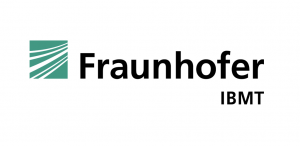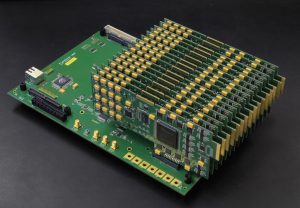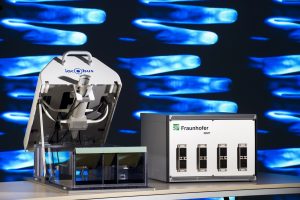 |
Fraunhofer IBMTIUS 2016: Booth N° 19 |
The Fraunhofer Institute for Biomedical Engineering IBMT acts as device and technology developer when it comes to the solution of individual research and development projects and tasks from the areas of biomedical/medical engineering, molecular and cellular biotechnology, biohybrid technology, cryo(bio)technology and nano(bio)technology, ultrasound technology, neuroprosthetics/implants, (mobile) laboratory technology, sensor and measurement technology, health telematics, environmental control systems, material testing, home systems, air quality control and security systems as well as laboratory automation including in-line/on-line process control. For more than 10 years Fraunhofer IBMT works in the field of stem cell research and hosts extensive cell line stocks in industrial and clinically structured biobanks for low temperature storage of valuable samples (fluids, cells, tissue fragments).
Division Ultrasound:
With more than 40 members of staff in two departments and eight working groups, it is the largest ultrasound research unit in Europe. The competences of the working groups are based on more than 20 years of experience, and allow the development of all system components from materials with specially adapted properties, to application-specific ultrasound transducers, electronic system components and software development procedures, right up to sensor production and process development. Services range from consulting and feasibility studies to laboratory prototypes and prototype development, right up to certified product development, licensing and evaluation, and are used by industry with a turnover share of approx. 70 %.
Medical Ultrasound:
Ultrasound, as a cost-effective, non-invasive and real-time capable method, can be used scalable on frequency ranges. The Department of Medical Ultrasound of the Fraunhofer IBMT, technologically implemented this scalability in a new unique modular ultrasound beamformer, which can be easily adapted to a variety of applications. In addition to the ultrasonic hardware, the department applies innovative software solutions that enable us to use ultrasound in medicine, biotechnology, the NDT and sonar. Specialities are systems and methods using optical laser combined with ultrasound (optoacoustics) that work with very high frequencies, are adapted to specific environmental conditions (hybrid imaging on MRI/pressure neutrality for use in AUVs and ROVs ) or are extremely compact for use with mobile devices.
Technical Ultrasound:
The Technical Ultrasound department integrates both the electrical and mechanical component know-how for an ultrasound system for non medical applications. With an appropriate combination of hardware and software it is possible to measure physical quantities like distance, level, speed, flow, volume and obstacle with high-precision. The developed ultrasound systems are specially adapted in terms of performance and price so that the systems can be well placed in the target market.The ultrasound sensors are very important for the overall system performance. Working frequency, beam pattern and sensor sensitivity have to be adjusted for the needs of an application. Before a new idea can be placed on the market, the development of appropriate sensors or the modification of existing sensors is necessary. The department assists customers on the complete way of product development or adaptation from the idea to the production and all relevant services.
- IBMT’s scientific ultrasound beamformer platform „DiPhAS“ with integrated multiplexer. The probe is based on a 1024-transducer (32×32) matrix arrangement with a pitch of 2 lambda and was designed for volumetric diagnostic measurements
- DiPhAS Beamformer: 3d/4d ultrasound beamformer system for use with matrix array transducers in research and OEM
- Combined ultrasound and optoacoustic imaging system IACOBUS. Tomographic imaging is performed in both modalities with a 768 element 10 MHz cMUT probe and a multichannel electronic system with 128 channels (80 MSamples/s sampling rate) and a 1-to-6 multiplexer.




